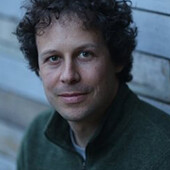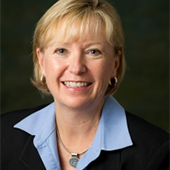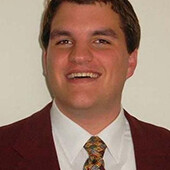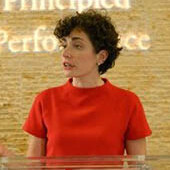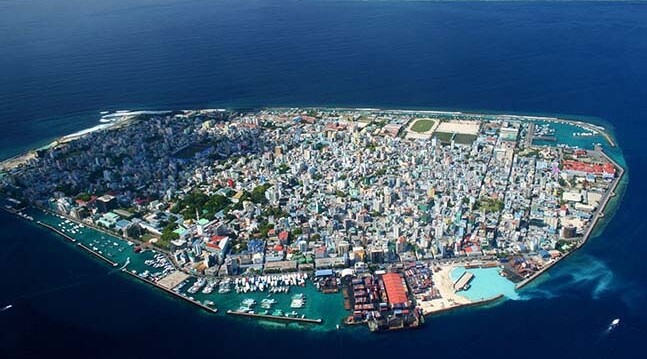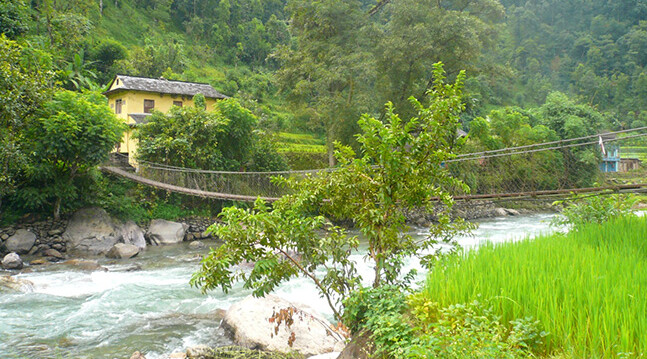Climate change is impacting the globe in surprising ways. The Maldives might be submerged, but Canadian trade could benefit from new waterways. What's the best way forward--short-term responses or long-term solutions? Don't miss the next episode, which looks at the shift from climate change mitigation to adaptation.
JULIA TAYLOR KENNEDY: You're listening to Impact from the Carnegie Council. Each episode, we explore a different topic in global business ethics. This time, it's climate change.
I'm Julia Taylor Kennedy. Our episode begins by zooming way in to the town of Jackson, in Jackson Hole, Wyoming.
LUKE LUKE HELM: My name is Luke Helm. I am currently the town infrastructure manager for the town of Jackson, Wyoming.
JULIA TAYLOR KENNEDY: What does climate change have to do with Jackson? Well, a lot, it turns out. After all, the area is surrounded by snow-capped mountains.
LUKE HELM: This year was a very weird year for ski resorts. There was basically no snow from about the Washington-Oregon border south down on the Pacific coast.
JULIA TAYLOR KENNEDY: The drought was so bad that some ski resorts in California didn't even open. Lake Tahoe got hit really hard. But that turned out pretty well for Jackson, which had a relatively normal winter.
LUKE HELM: We had huge, record-breaking numbers of skier visits here because there wasn't any snow in California.
JULIA TAYLOR KENNEDY: Good news for a town where the economy revolves around tourism. That supports the companies running the resorts, who feared a decline in visitors as winters got warmer. That supports people who work there, who need jobs.
LUKE HELM: That supports and pays for all of our public infrastructure, through the sales tax, lodging tax, and stuff like that.
JULIA TAYLOR KENNEDY: Even though climate change has been predicted for decades, it impacts the globe in some surprising ways. It is not bad for every individual, every company, or even every part of the world—for now.
On one hand, the Maldives may be submerged. On the other hand, Canadian trade could benefit from a new waterway through the Arctic. Guatemala might be ravaged by stronger hurricanes, but Greenland is able to harvest a new potato crop.
The primary debate is no longer between climate change deniers and believers. Now that we're starting to see evidence of climate change, now that glaciers are melting, the conversation is more nuanced and more urgent.
Governments, businesses, even the United Nations are talking about adapting to climate change, as well as trying to reverse it. But what should our priorities be?
In the short term, government and industry is under pressure to respond to extreme weather and other unexpected side effects of climate change—which aren't always negative. Advocates push them to also keep long-term solutions in mind, along with questions of global inequality.
MCKENZIE FUNK: My name is McKenzie Funk and my book is called Windfall: The Booming Business of Global Warming.
JULIA TAYLOR KENNEDY: In writing his book, Funk found all kinds of fascinating stories in which the main characters earned profits from the effects of climate change.
One, coincidentally, had to do with a snowmaker invented by an Israeli engineer.
MCKENZIE FUNK: Alexander Zarchin—he was born in Russia and he was sent during Soviet times to a gulag for being a capitalist.
The gulag was up in Siberia, up in the far north, where it's quite cold, of course. But it's also quite dry. And in this gulag they didn't have a good way to access drinking water.
Someone, I'm not sure if it was Zarchin himself, came up with the idea that if they could make a pond next to the ocean, and then let a bunch of saltwater in from the ocean, then when that freezes in winter—of course, when you freeze water, the ice has no salt in it—it separates it.
JULIA TAYLOR KENNEDY: Zarchin would let the pond freeze in the winter. Then after the spring melt started, he'd open a gate to release the salty water from under the ice. And he would test the water as it flowed into the ocean.
MCKENZIE FUNK: So you can imagine this big chunk of ice and snow on top of the pond—and then underneath it this water is trickling out and they are measuring the salinity.
When they finally said, "Ok, this is drinking water," then they would dam off the pond again and they would let the rest of it melt. Then they would have a whole pond of fresh water.
JULIA TAYLOR KENNEDY: It's a pretty ingenious trick for the gulag, but turned out to be hard to replicate in warmer climates.
Zarchin later returned to Israel and figured out how to replicate the process with a very cold vacuum chamber. Other desalination techniques have turned out to be more efficient for high volumes of water, but the vacuum desalination technology is now gaining in popularity for snowmakers. After all, it separates pure cold snow from ocean water.
MCKENZIE FUNK: So IDE, the desalination company, is now selling its snowmakers to the Alps. There's one such snowmaker in Austria that I visited. The ones in Switzerland and Austria are these big boxes sitting next to the foot of a melting glacier.
With a typical snowmaker, when they do it, you need the air to be freezing. You need the humidity to be a certain level. And with these giant vacuum boxes they can make snow in any conditions, which in a warming world is a lot more helpful.
JULIA TAYLOR KENNEDY: Maybe resorts in Jackson Hole and Lake Tahoe will be the company's next customers.
But while the desalination company is growing this sideline snowmaking business to replace the snow that's disappearing off of ski slopes, Funk sees all kinds of other companies scrambling to figure out how they will survive in a world that may change quite a bit in the next few decades. Funk says even companies that don't want to be scrambling are having to scramble. Even companies that are investing in risky, long-run projects like oil.
MCKENZIE FUNK: You don't put up a platform and pump out a bunch of oil in the course of a year or two. This is a 30-year project. Oil companies are very much interested in the future.
JULIA TAYLOR KENNEDY: Shell Oil is especially good at predicting crisis, something the company calls scenario planning.
MCKENZIE FUNK: And so, with scenario planning, Shell had seen the twin oil shocks in the '70s coming. They had seen the fall of the Soviet Union.
JULIA TAYLOR KENNEDY: A few years ago, just before a big global summit on climate change was to take place in Copenhagen, Shell released a plan that framed two potential global scenarios for climate change. The first scenario was called Blueprint.
MCKENZIE FUNK: That's a kind of greener world. A world where we make plans to cut back on carbon and come up with alternative sources of energy.
JULIA TAYLOR KENNEDY: The second scenario was called Scramble.
MCKENZIE FUNK: Scramble is what you can imagine is just a scramble for resources and not doing too much about cutting carbon emissions or anything like that. It's just sort of grabbing what you can, when you can.
JULIA TAYLOR KENNEDY: Shell wanted to avoid a scramble.
MCKENZIE FUNK: In 2008, they came out with these that said, we actually think that Blueprint is better for us and better for the world.
Of course, they were very upfront about the fact that climate change is caused from oil and gas and it is something that they want to fight against.
JULIA TAYLOR KENNEDY: So, on the eve of this global summit on climate change, Shell was calling on the global community to write a blueprint. To come up with a plan that could get industry, government, and advocates moving in the same direction: to get rid of climate change.
MCKENZIE FUNK: The "regulate us" push came very loudly from Shell. You had the CEO at the time, Jeroen van der Veer, saying that it's hogwash to think that the market can just do it all by itself. We need regulation. We need a carbon cap, and that was part of it.
JANET PEACE: Companies want some certainty.
JULIA TAYLOR KENNEDY: That's Janet Peace, vice president of the Center for Climate and Energy Solutions in Washington, DC. She's also an economist, and she's been thinking about climate change and the free market for more than 20 years. As many economists know, carbon emissions—the major cause of climate change—are a funny animal when it comes to economics.
JANET PEACE: There is a cost that is being imposed on society that we just don't take into consideration when we make our decisions.
JULIA TAYLOR KENNEDY: In economics those costs are called negative externalities. Think about prices of goods that you buy every day. They're based on labor and materials costs. A flower vase made in China, which travelled a long way in high-emitting airplanes and diesel-belching trucks, takes a greater toll on the climate than one that's made by a local glassblower. But the locally made product will cost more, because of the cost of labor and materials. The externality—the carbon emissions, the cost to society—isn't baked into the price.
JANET PEACE: The ultimate objective is to put this price so that people think about the cost of these emissions in their everyday decisions. So if you have to choose between this product over here that has a lot of carbon embedded in it or this product over here that doesn't have much carbon embedded in it, you want people to say, "Okay, I want to choose the less-carbon option." And it makes sense. You are using the power of the market to inform people's decisions.
JULIA TAYLOR KENNEDY: But companies won't start baking the cost of carbon emissions into their products on their own. Competitive factors are just too strong. Companies might cut their emissions a bit to save on energy costs, but that doesn't have a huge impact on price.
Peace sees solutions cropping up here and there, where local governments are getting involved.
JANET PEACE: Maybe it's more of a bottom-up process. California has a price on carbon; nine states in the Northeast; five provinces in China; Alberta, Canada, has a price on carbon; British Columbia has one; Quebec just linked with California. So there's lots of places.
JULIA TAYLOR KENNEDY: These solutions start to sound like more of a scramble than a blueprint. McKenzie Funk traces the scrambling back to 2008.
MCKENZIE FUNK: Copenhagen was more or less a bust. The agreement to keep on talking came out of it. There were some minor things salvaged. But, for the most part, it didn't happen. Everything from the oil companies saying, "Okay, well, if there's not going to be a price on carbon yet then let's not change our business models too quickly to meet it." That's one thing that happened.
JULIA TAYLOR KENNEDY: So even though Shell wants a blueprint world, it's just scrambling?
McKENZIE FUNK: It's become a "scramble world," not blueprint. Shell's in the business of making money.
If you ask their scenario planning team now about what happened since 2008, they will say that it looks more like a "scramble world." Governments and people didn't push society to really put a cap on carbon or do any of these things that would set the market conditions for us to do blueprints. As much as at that time we preferred blueprints, if it's a "scramble world," we're going to scramble too.
JULIA TAYLOR KENNEDY: Add to the scramble more public awareness of extreme weather events that are likely early signs of climate change. Add to the scramble an increased push for adaptive technologies to protect coastal cities. Add to the scramble President Obama's 110 million dollar Climate Action Plan. Add to the scramble northeast United States and Europe setting carbon reductions targets that are criticized for being too low.
A scramble is less intentional than a blueprint. It has an air of "every man for himself," and that can be unfair to those who were born with less.
BJØRN LOMBORG: My name is Bjørn Lomborg. I'm the president of the Copenhagen Consensus Center and an adjunct professor at the Copenhagen Business School.
JULIA TAYLOR KENNEDY: Lomborg thinks we're scrambling in the wrong direction.
BJØRN LOMBORG: Do we need to tackle it differently? The simple answer is yes, because we've managed to cut virtually nothing of CO2 over the past 20 years. So it's very clear, and I think everybody agrees, we need to do something.
JULIA TAYLOR KENNEDY: But he doesn't think the answer is either a global cap on carbon or a focus on wind and solar.
BJØRN LOMBORG: We seem to almost exclusively have decided to say, "Let's spend quite a bit of money to feel good about doing something," instead of actually doing good.
Right now the rich world is paying on the order of 100 billion dollars a year on subsidies. It makes us feel good to put up some solar panels and wind turbines. It doesn't do very much. Remember, the rich world gets about 1.2 percent of its energy from wind and solar. Globally, we get about one-third of 1 percent of our energy from solar. You could say that's almost a penance that we are paying to feel good about this.
JULIA TAYLOR KENNEDY: Lomborg isn't using that phrase "the rich world" lightly. He is known in climate change circles for being a bit radical. He has some very original ideas about short-term and long-term responses to climate change. For example, Lomborg finds the Global North—the richer nations in North America and Europe—have reversed incentives when it comes to climate change.
BJØRN LOMBORG: What the economic estimates indicate is that moderate global warming will probably be a net benefit for the world. That means it will probably be worse in third world countries and it will be better in rich countries, which are typically mid- and high-latitude countries.
JULIA TAYLOR KENNEDY: Lomborg thinks "moderate climate change" will pivot into bad news for everybody by 2070. But in the next 50 or 60 years, he says, the developing world has more pressing problems.
BJØRN LOMBORG: The most renewable continent in the world is Africa. Africa gets about half of their energy from renewables. And it's a terrible place in many ways. These renewables are basically wood and dung and cardboard that they cook and keep warm with and pollute their indoor homes, making it probably the world's biggest environmental problem. We estimate about 3.5 million people die from indoor air pollution, mostly in third world countries.
JULIA TAYLOR KENNEDY: President Obama is working on bringing wind and solar to Africa.
BJØRN LOMBORG: Obama, very laudably, says that he wants to help get electricity to six African states and basically get people out of poverty. But if you do the numbers, what they show is that if you spend 10 billion dollars on helping people out of poverty in Africa, if you do it with renewables, you will help 20 million Africans out of poverty. If you do it with gas, you will help 90 million people out of poverty.
JULIA TAYLOR KENNEDY: Gas, of course, is more affordable. And it emits more carbon.
BJØRN LOMBORG: Do we want to say, "No, global warming is more important; no, you can't have fossil fuels, you should only have renewables," and leave 70 million, or more than three-fourths of all the people that we could have helped, in darkness and poverty? I don't think anyone reasonably can say they would want to opt for that option. Yet, that is how we act mostly. We say, "You can't have fossil fuels," whereas, of course, most of the rich world is dramatically using fossil fuels. That is probably a little hypocritical.
JULIA TAYLOR KENNEDY: For Lomborg, the way out is to get affordable energy to the Global South. Meanwhile, the Global North should fund research into affordable, scalable green energy technologies before climate change gets really bad in the second half of the century. In essence, take the time to blueprint, develop a more ambitious fix.
BJØRN LOMBORG: That's the only realistic solution: come up with technologies that are so cheap that eventually everyone will want to switch. In that way we tackle poverty in the short run and we make sure that all the world switches over in the long run to green energy sources.
That's about making it so cheap you don't need to subsidize it. It has to be about innovation. We should be spending the money on researchers rather than spending it on stuff that we already know is not effective.
AXEL WINTER: My name is Axel Winter. I am working in the CODAC (control, data, access, and communication) section of ITER (International Thermonuclear Experimental Reactor). I am basically responsible for the real-time control in ITER.
JULIA TAYLOR KENNEDY: In other words, Winter is part of an international team based in France that is working to develop nuclear fusion.
AXEL WINTER: ITER was conceived in 1985. That was back in the days when there was a Cold War and when there was an Iron Curtain. That was the result of a meeting between Mikhail Gorbachev and Ronald Reagan. In one of their big summits, they agreed that this nuclear fusion research was worthwhile for these two superpowers, together with Europe and Japan, to start a collaboration to get this done.
JULIA TAYLOR KENNEDY: At the time, when there were still nuclear warheads pointed across the Atlantic, this was an effort to get a collaboration between these two nations going.
AXEL WINTER: People started working on it in the subsequent years. That took a long time, because it's not an easy task. In 2005 and 2006, they made the decision to build this proposed design. The decision fell to build this machine in Cadarache here in southern France.
JULIA TAYLOR KENNEDY: So, for the past eight years, scientists around the world have been collaborating to create a nuclear fusion plant. Fusion enthusiasts think this could be the cheap, green energy solution that policy expert, Bjørn Lomborg is looking for. Here's how it works.
AXEL WINTER: Essentially, fusion is the combination of two atoms of hydrogen.
JULIA TAYLOR KENNEDY: The combination is pretty powerful. After all the sun's brightness comes from fusion.
AXEL WINTER: This reaction releases energy, and if you use this to generate power, the idea is to basically heat water—something that you do with any other power plant as well. You heat water, use that water for steam that you generate to drive turbines and generators, and create electricity that way.
JULIA TAYLOR KENNEDY: Sounds pretty simple but here's why it's actually really hard to control.
AXEL WINTER: You can get the answer already when you look at the sun. The sun, as we know, is a very, very hot ball of gas. Really, the difficulty is these hydrogen nuclei.
JULIA TAYLOR KENNEDY: The hydrogen nuclei don't want to combine.
AXEL WINTER: When two of them approach each other, they tend to repel. There is a very strong force that drives them apart. So what we need to do is we need to heat this hydrogen gas up to very, very high temperatures. What we usually use here is something on the order of 100 million degrees Celsius.
JULIA TAYLOR KENNEDY: That is really hot. So hot, we currently don't have any materials that can withstand those temperatures. This has stalled the fusion project. ITER scientists have decided the only way to control the temperature is to use magnetic fields to contain the heat.
AXEL WINTER: What we do is we use a high number of magnets to provide a very special magnetic field that allows these particles—this very hot gas—to travel around essentially in a circle without touching any of the exterior walls. This is a very tricky process.
JULIA TAYLOR KENNEDY: Tricky, yes, but this international team thinks fusion can replace coal and natural gas as primary energy sources. The materials it uses are abundant on earth. The idea is to develop a prototype in France that can be replicated around the world.
AXEL WINTER: It will be part of a mix that will involve maybe fusion reactors to serve as a baseline power source, basically to replace the fission reactors and the coal-burning, fossil fuel plants of today.
JULIA TAYLOR KENNEDY: The upside? It's clean technology. Unlike nuclear fission—which is used for existing nuclear power plants with highly radioactive, long-lived runoffs—nuclear fusion's waste is far safer and degrades more quickly. But will it answer Lomborg's call for an affordable source of power?
AXEL WINTER: The aim should be to be able to build a fusion power plant at roughly the cost of what a big fossil fuel power plant costs these days or a big nuclear power station costs these days.
JULIA TAYLOR KENNEDY: There are still many unknowns about fusion. Whether it can be replicated around the world. Whether it can be as affordable as coal.
AXEL WINTER: Fusion is, again in my personal opinion, the only viable candidate for the long term. This should be the equivalent of an Apollo program, where in the 1960s the United States had the vision and the dedication to say, within this decade, we will land on the moon.
Get it done and take the resources that you need to get it done. But get it done.
JULIA TAYLOR KENNEDY: Yet the funding for fusion today is nothing like the funding for solar and wind power.
AXEL WINTER: In the last 10 years, when private solar panels on roofs were very heavily subsidized, the German people basically committed 100 billion euros into paying for these subsidies.
JULIA TAYLOR KENNEDY: That works out to nearly 7 billion U.S. dollars per year spent in Germany on solar panel subsidies. That's 14 times the amount in the 2014 U.S. budget earmarked for ITER.
AXEL WINTER: You see that evidently there is a slight discrepancy here between what has gone into photovoltaic and what is going into fusion.
JULIA TAYLOR KENNEDY: Here, we get back to Lomborg's core argument: that resources should be shifted from expensive renewables to research for cheaper, more scalable energy sources. Ever the skeptic, Lomborg is not sure fusion is the answer.
BJØRN LOMBORG: I'm not a technology guy, and I don't really think anyone can tell you. Is fusion going to be the answer? Probably not, if the past is any indication, because most projects fail. That's okay. We just fund 1,000 of these projects and two break through, and they're the ones that will power the 21st century.
JULIA TAYLOR KENNEDY: So maybe our choice isn't between blueprint and scramble. Maybe a blueprint is just too hard to write. There are bound to be unpredictable outcomes as climate change intensifies. Jackson, Wyoming ski tourism may boom as Lake Tahoe's snow melts.
In the course of reporting his book, McKenzie Funk met a lot of people who he assumed were out to exploit the side effects of climate change.
MCKENZIE FUNK: One of the main takeaways for me from this project was going places where people have been vilified for what they are doing, and realizing that they're not bad people. There's more at work always than profit motive. Most people want to be good. I didn't see a lot of really obvious evil out there. Most people have a system of ethics that they try to follow. Even if they are very different than what mine might be.
JULIA TAYLOR KENNEDY: That also goes for people who argue about whether a carbon tax or a new technology is the right solution.
MCKENZIE FUNK: It's a matter of understanding that we cling to certain ways of thinking about the world. Some of those might not actually make much sense as the world changes. We can veer towards techno utopianism. We can veer towards very free market capitalism. We can think that these are almost up to the level of religion sometimes.
JULIA TAYLOR KENNEDY: Maybe, instead of putting pressure on international bodies to design a detailed blueprint, we need to align our goals another way. Maybe we need to agree on a set of priorities. Maybe we need to agree on a set of values that drives how governments, schools and research firms spend their resources.
MCKENZIE FUNK: The idea that people are just going to be out for themselves, and just going to do the wrong thing to make a quick buck—I don't think so. It's a matter of getting perspective on what it is they're doing.
If you can step back and are less dogmatic then people make more human decisions. Religion's not the only dogma out there. So, maybe it's the belief system that needs to be looked at, not the people. And not have the people be vilified. There's some hope there.
JULIA TAYLOR KENNEDY: Thanks for listening to Impact from the Carnegie Council, and a special thanks to our production team Mel Sebastiani, Terence Hurley, Deborah Carroll, and Amber Kiwan. I'm Julia Taylor Kennedy. You can find out more about this podcast at carnegicouncil.org.
The next episode of Impact will look at a related challenge: how governments, companies, and even the UN are beginning to shift from climate change mitigation to climate change adaptation.

